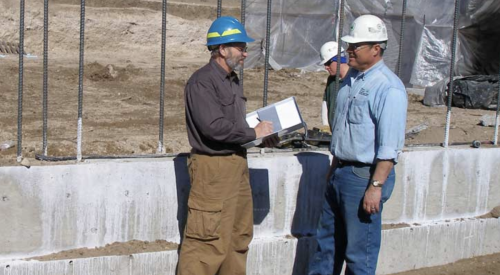Who hasn't been at a desk or on the job and wished for a better way or better tool to complete the task at hand? "If only I had ..." most often floats through our minds, slips through our lips and leads nowhere. But sometimes wishing turns to action and results in a new invention - the proverbial better mousetrap.
Some inventions transform civilization - the light bulb, the automobile, the assembly line. For better or worse, so did the cell phone that takes pictures. Others lack the reach of these inventions but succeed in a smaller niche.
Some builders have a Thomas Edison side or, rather, a recurring pressing problem they would love to eliminate with a push of a button, a wave of a wand or even hard work. On the following pages, they express creative ideas for inventions that could overcome obstacles they face and affect how homes are built and marketed.
|
Customer Information Centers
Steve Wall, president and CEO of Arlington, Texas-based Choice Homes, says the industry needs a few more people like Henry Ford. "Our industry will evolve more in the next 10 years than it did in the last 10," he says. "It will evolve in ways to serve the customer with creative products. Car companies come out with new models every year, and that's the only way they can get people to trade in that old one on a new one. A lot of us have come out with the same products over the years, and I think the builders who will thrive over the next 10 years are the ones who are creative.
"One of the things I'm working on is having a center where consumers can come in to learn everything they need to know about buying their first home," Wall continues. "There is so much a person doesn't know about the ramifications of buying a home. For example, what kind of storage areas are they going to need? We would be a customer or prospect resource as opposed to just delivering and selling homes."
Building Material Innovations
Harry Thurgate of H.R. Thurgate and Son in Jericho, Vt., says his customers expect more technology these days. They expect the builder to demonstrate "efficiency technique, energy technique and structural technique," he says, as well as "the handling and use of materials that are less susceptible to environmental conditions. As an industry, we have to attract better-educated, better-informed people to deal with better-educated, better-informed clients."
That education equation includes more advanced materials and more thoughtful use of them, Thurgate says. His customers expect certain products with certain performance levels because power companies, insulation companies and even insurers urge their use.
"We make houses so tight it's almost unhealthy, so we need air-exchange systems relevant to the cubic footage of air that's there," he points out. "You have off-gassing because of propensities in the products - the nails and glues that are used, for example. Carpeting produces off-gassing. You can have pathogens in the air that get sucked into a building if it's too tight. The materials that you need to reduce those and that can also increase the strength are crucial, too."
Thurgate wants more emphasis on "better plywoods, water-resistant materials to apply to roofing and membrane applications." He wants "housewraps that actually work and breathe and ventilation systems that actually work and accomplish what they should." He recommends "the introduction of 120-cfm fans in every bathroom, for example, and put them on a timer."
Such products address widespread concern with mold and mildew, problems that Craig Reed, owner of Accent Builders in Virginia Beach, Va., would like to see tackled with new products. "I haven't seen any alteration in industry-standard practices to prevent mold and mildew within the wall other than what we've been doing for years," Reed says.
Abe Degnan of Degnan Design echoes their concern but says, "We have not had any problems with our construction methods with the Dow Intelligent Wall System we use."
Hardware, Software and Builderware
Degnan's wish list includes better software to improve operations and customer communications. He uses QuickBooks Premier Contractor Edition and the Autodesk Revit design and documentation system.
"I'd like to see better product integration," Degnan says. "It seems like I often have to do data entry in both a spreadsheet and then QuickBooks. For scheduling projects, I do stuff in Microsoft Outlook, and then I have to duplicate that in a word-processing document to fax to my subcontractors. Better integration of products would be great to reduce the amount of data entry."
Reed is shopping for a laptop and software that would enable him to carry "CAD software and some preliminary floor plans on site so I could give the homeowner some idea of design changes on the initial design." This also would serve as an address book and organizer for the subs with whom he deals and replace the shoulder-strap briefcase Reed now uses to carry his contract numbers and books.
"I don't know if there's software available to do all that, but I know there's a market for it because all the subcontractors and other contractors I know have expressed a desire to have that centralized information in a mobile form," Reed points out. "There's a lot of communication it could help with, not only between me and the designer or architect, but the homeowner as well. It's a three-way circuit."
Reed concedes that his vision of what this hardware/software package should do is pretty specific and far-ranging, but he also can see the potential.
"Customers don't expect the builder to have tools like that, but they're awfully impressed if you do," he says. "Image is key when you first meet with the customer, and if you whip out a laptop and show them preliminary designs, you're going to make a good impression. I envision just showing up with a laptop and tape measure, taking preliminary measurements, transferring them immediately to the laptop and giving them right there on the spot an idea of what their design might look like.
"I would like to have that type of presentation where they could see an overview of what we're talking about so they're on the same page as I am," Reed continues. "It would make the whole bidding/estimating process a lot clearer to myself and to the customer. The final numbers would be nailed down with the submission of the final drawings."
The package's utility would continue after the sale, too. "I would also use it to manage my customer database," Reed says. "Any warranty issues that came up, I would have complete access to their file, which shows all the work that was done and all the products that went into the home. If they were to tell me they have a problem with a patio door, and the door was an Andersen that comes with a one-year warranty, then I would know that.
"But it would be worthless if it did not have networking capability," Reed adds. "What would be accessible through the laptop would have to be the same information as through the office. It would have to be basically a mobile desktop."
Cell Phones for Big Thumbs
While on the subject of electronic gadgets to make a builder's life easier, Reed vents about one that has become indispensable. "Thousands of people across the country, from subcontractors to developers, depend on cell phones because they're out in the field and running around all day," he says. "But they're making phones smaller and smaller so they can market them to teenage girls at the mall. They just don't last! Make them big enough for us construction guys' big hands and thumbs.
"They have phones in Europe that are shock-resistant, dust-resistant and water-resistant," Reed notes. "They have rubber grips. They're nice phones. But apparently they don't think there's a market for that in America."
Sounds like American builders need the next Henry Ford or Thomas Edison.










